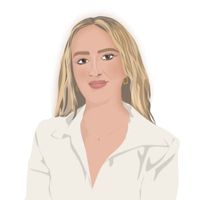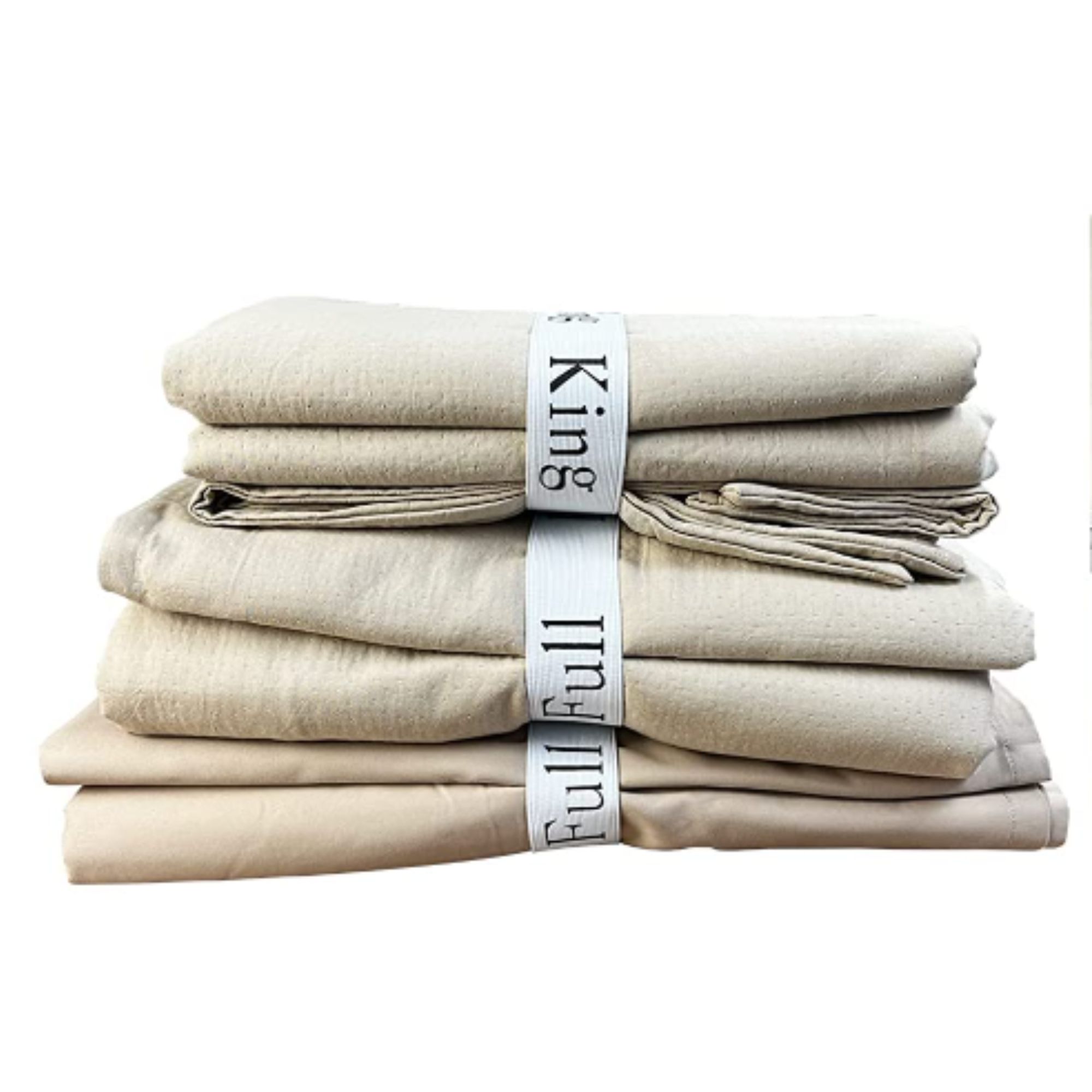How to wash your bed sheets for the freshest results
Bubble bath, fresh sheets, and a good book... yes pls


As sad as it sounds, there's nothing more I look forward to than my self-care nights. If my schedule allows it, it happens every Thursday (if not, then every other), and it involves a full lineup of skincare, a bubble bath, and getting into fresh sheets before reading my book or watching a bit of trash on TV. Honestly, there's no other feeling I find as satisfying as slipping my freshly shaven legs into my silky bedding. IYKYK.
But knowing how to wash my bed sheets properly has definitely made all the difference in my routine. Washing, drying, and storing bedding correctly can help keep the fabric in good condition and more importantly, clean. If you're just throwing your bedding in the machine at the same temperature and leaving it to dry, you could be missing out on some seriously soft sheets.
To make sure you're looking after yourself and your bedding in the best way possible, I've spoken to some experts for their step-by-step guide on how to wash bed sheets — because hygiene, obvi.
Oh, and ICYWW, this is exactly how often you should be washing your sheets.
How to wash bed sheets
Good to know

As a general top tip: we'd always suggest reading the care label first and checking the washing symbols on your sheets for the best results. Common bedding materials like cotton or linens have general washing guidance, but sheets made from fabrics such as silk, wool, or certain synthetics may require special treatment.
Here's what you'll need
- Your washing machine
- A good stain/spot remover, I use Carbona Stain Devils
- Mild laundry detergent, like Method's eco-friendly detergent
- An iron (optional)
- Wrinkle-releaser spray (if you're wanting to avoid the iron)
1. Treat any stains
Strip your bed, and as you do so, check for stains. It's the perfect time to find fake tan marks, coffee spills, or any other accidental stains. If possible, it's best to deal with fresh stains right away, but if it's too late, old stains can be treated by dampening the fabric and adding stain remover with a bit of diluted detergent.
FYI: If you do need to remove blood stains, we've sourced the most effective method from experts, too.
Get small space home decor ideas, celeb inspiration, DIY tips and more, straight to your inbox!
2. Wash the sheets in your washing machine
Follow the temperature instructions on your sheets, but aim to wash at 100 degrees Fahrenheit to kill germs. Despite the common idea that the hotter the wash the better, Parima Ijaz, founder of Pure Parima and Tony Klespis, a certified sleep science coach at Mattress Clarity, recommend washing your sheets in cold or warm water. Washing your sheets in water will "preserve the color and delicate fabric" says Ijaz. For the best results, "use cold water, mild detergent, and a gentle cycle" adds Klespis. It's also important to not overload your washing machine as it could damage both the machine and your linens, preventing effective cleaning. The washer tub should not be more than three-quarters full.
While this is a general way of washing your bedding, different materials will need extra treatments, so make sure to pay attention to whether you're washing cotton, linen, bamboo, or silk for example.
- Silk bedding: Washing silk will need delicate handling, at a cool temperature or even hand-washed if possible. It's also a good idea to wash it inside out to protect the fibers from breaking down.
- Bamboo bedding: It's best to wash bamboo bed sheets in cold water. They're known for a brushed soft-to-the-touch feel that can be damaged if washed with hot water.
- Linen sheets: Since linen bedding is known to get softer with every wash, it's important to maintain the fabric's properties as much as possible. A great hack is to turn the covers inside out and separate them from other materials to avoid any harsh friction in the machine.
3. Dry your sheets
Once the wash cycle has finished, Klespis' top tip is to shake out your bedding. This will work out some wrinkles and untangle any sheets that may have knotted up. You can tumble dry your sheets in the dryer, but hanging them outside to dry on a sunny day is a quicker and more eco-friendly way (though avoid this if you have pollen allergies). Alternatively, dry your sheets on a drying rack inside and finish in a tumble dryer on a low and slow cycle to remove creases and add softness. Check the care label to find what temperature is best depending on the material your sheets are made of.
4. Optional: ironing
If you dislike ironing, then you'll be pleased to know this step is entirely optional. Yes, your sheets may look wrinkly AF, but they'll soon drop out even after one sleep. If you also fold your sheets right away, there may be minimal creasing. If you don't mind the occasional ironing session, then steaming your sheets til they're smooth will make your bed look pretty luxe. Again, it's good to check the care label for ironing advice.
Real Homes hack: You can also use a good wrinkle releaser spray on your sheets once you've made the bed. Simply spray and watch the creases fall out.
5. Store your sheets correctly
Rule number one: Never put damp sheets away as they will start to smell. Keep them in a linen organizer in a well-ventilated space, such as a linen closet if you can. Conversely, you can use clothes storage bags for long-term storage.
A clever way to store your sheets is to keep sets together, using the pillowcase as a bag. This means you'll have a set ready to grab when needed. You might want to store them file-style in a basket so that you can see the right set, top-down.

Want easy, practical access to your sheets? With the zip front on these boxes, you can simply rotate your sheets without having to pull boxes in and out of your closet every time. The cube shape also looks really smart, whether you plan to stack or store them in a row.

This cotton linen storage bag, with its grid pattern, is fab if you don't care about seeing your sheets when they’re tucked away. It’s also stylish enough that it won’t make your home look cluttered — great for anyone living in small apartments with very little cabinet space.

If you want to go one step further on the organizing front, you can tie your sheets together with these organizing labels before placing them in bags. Not only will they make your sheets look like they’ve come straight off your Instagram feed, but they’ll stop you from getting all the different sizes mixed up.
FAQs
How to keep your bed clean
Having good sleep hygiene isn't just about washing your bed sheets. It sounds like a lot, but it's important to regularly wash the rest of your bedding.
Make sure you give your mattress an added barrier between sweat and dead skin cells (ew) with the best mattress protector, and yes you can wash a mattress cover, too.
Avoid eating in bed. We would say no to drinking in bed, too, but where is the joy in life if you can't wake up with a nice cup of coffee?
Regularly (about once a month) wash your duvet and find out exactly how to wash your pillows too, as this can vary by filling.
Give your bedroom good air every so often. Fling the sheets back before making your bed to expose your bed to sunlight (this helps lessen bugs and germs).

Louise is the Ecommerce Editor at Real Homes, specialising in sleep content so you can wind-down well. With prior PR experience working for a luxury bedding brand, Louise knows the importance of getting a great night’s sleep. Joining the other side of the desk as a full-time journo, Louise brings her bedding expertise to writing sleep buying guides, reviews, and news for Real Homes. Aside from helping readers get essential shut eye, Louise also writes shopping content for homeware items that’ll add a decorative edge to your space. With an eye for design that won’t snooze on style, but a budget that won’t quite stretch, Louise loves nothing more than a modern designer dupe. From coloured glassware to contemporary storage, anything to upgrade the bare space of her rented East London flat.